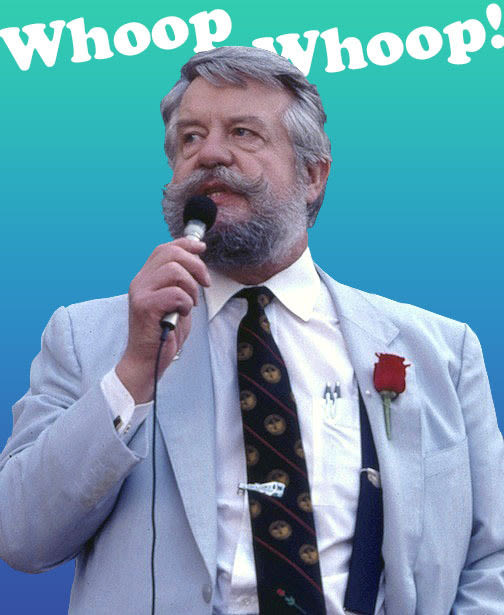5 Reasons Bud Clark Was Portland’s Most Unforgettable Mayor

In the half-century, only two people have served two full terms as Portland's mayor (Ted Wheeler, dude, you've still got a ways to go). One was three-termer Vera Katz, a savvy vet of the legislature who was Oregon's Speaker of the House before she got to city hall. The other was a bicycling bar owner with no prior political experience and a "whoop, whoop" greeting who went by the nickname Bud. John Elwood "Bud" Clark died Tuesday from congestive heart failure, at age 90.
The surprise winner over chamber-of-commerce-type Frank Ivancie in 1984, Clark was best known before his election for running the Goose Hollow Inn tavern and posing for a photo contest as if he were flashing a statue. His approachable outsider status set the tone for his term in city hall. Portland's "best" mayor is up for debate, but here are five reasons he was the city's most unforgettable leader.
1. That Photo
Ask someone now what image they most associate with Portland, Oregon, and there’s a good chance Fred and Carrie pop up; maybe a dystopian image from the summer 2020 protests. Ask the same question in the ’80s, and one image was likely to sweep: Portland’s “maverick” mayor Bud Clark flashing a bronze sculpture on SW Sixth Avenue, above the caption “Expose Yourself to Art.” Taken six years before Clark’s city hall tenure began, the photograph was captioned through a Northwest Examiner contest and then widely distributed by its photographer, Michael Ryerson. During Clark’s bid for mayor, the image resurged, offering an early shorthand for the Rose City’s “weirdness” to the fascinated masses. Its popularity persists—until his death, Clark rarely gave an interview that didn’t touch on the image—and as for any queasiness it may cause some 40 years on, the former mayor regularly clarified that he was, in fact, clothed in the photo, wearing a shirt designed to discourage local high schoolers from contracting gonorrhea that read “Zap the Clap.”
2. Barkeeping Chops
Even if its longtime owner hadn’t been elected mayor in 1984, the Goose Hollow Inn would have plenty of claims to fame: its role as a de facto community center, a hangout for actor Al Strobel (Mike the One-Armed Man on Twin Peaks), a most worthy Reuben on its sandwich menu, and a patio that can feel like both the center of the universe and a shady escape from everything. But get elected he did, and Bud Clark took office as “the People’s Mayor.” Being “just a tavern owner” might have been the key to his election, keeping his opponent from taking him too seriously. And bartending, while not a traditional background for an elected official, grants deep experience in counseling, communication, public safety, balancing group dynamics, meeting people where they are, multitasking, recognizing alliances, and, of course, seeing who needs a refill.
3. Being Neighborly
At its core, Portland is a city of neighborhoods, each its own microcosm. For proof, look no further than former city commissioner Chloe Eudaly, who took on the city’s entrenched and influential neighborhood associations and lost her bid for a second term. If career longevity had been her goal, she could, perhaps, have taken a page from Clark’s book. Before he ever entered politics, he was involved in hyperlocal issues like where to site parking garages around just-starting-to-bustle NW 23rd Avenue, where he lived with his wife and their children in a sprawling Craftsman that was once a brothel. Clark—described in virtually every stemwinding profile as being a “populist”—also founded the precursor to the Northwest Examiner, today one of the scrappiest and best-regarded in the city’s constellation of free local neighborhood papers. Ultimately, he believed to his core that it was vital to have a direct line to all the people of his city; in a 2011 interview, Clark recalled that during his initial, improbable run for mayor, he based his platform on “issues from the people, from the coffees that I went to.” Who hosts coffees? Neighbors, that’s who.
4. Showmanship
Clark was enough of a showman to appear on The Tonight Show with Johnny Carson before he took office, where he charmed the legendary host into imitating his signature “whoop, whoop!” greeting offered to any Portlander he’d encounter whilst biking around the city. But he had his standards—the city’s cheerleader in chief he might have been, but when asked to make a cameo on the then more ribald show hosted by one David Letterman, he declined. For one thing, a spokesman explained to a wire reporter, he didn’t want the boundary-pushing Letterman to poke fun at him—and, by extension, Portland. But for another, he was in office now, and couldn’t spare the time to fly to New York. Clark had a job to do, and a city he needed to do it in, and no matter how bright the lights of Broadway might beckon, he couldn’t be budged.
5. A New Approach to Homelessness
Clark garnered national attention—and millions in federal funds—for his initial 12 Point Plan, launched back in 1986 when homelessness was becoming an increasingly visible issue on Portland’s streets. That plan evolved into a series of reports called “Breaking the Cycle of Homelessness: the Portland Model,” which directed a huge increase in funding toward helping the city’s homeless. The plan was marked by an approach that included wraparound services for addiction and mental health treatment, case management, and employment initiatives. Considered a major turning point in addressing homelessness, it has in many ways informed policy to the present day. Such was his legacy that the homelessness services center Bud Clark Commons was named in his honor.




